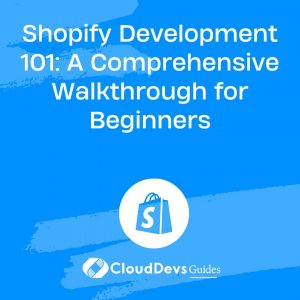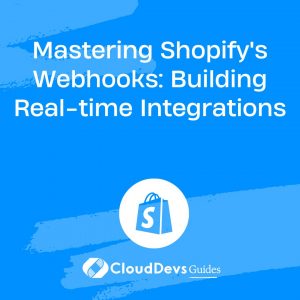Shopify Development 101: A Comprehensive Walkthrough for Beginners
Shopify is a highly versatile platform that enables businesses of all sizes to create customizable and attractive e-commerce stores. Whether you’re a newbie considering dipping your toes into the world of Shopify development, or a business owner contemplating whether to hire Shopify developers for a professional touch, you’ve arrived at the right place. This comprehensive guide will delve into the essentials of Shopify development, from setting up your store to more advanced topics like Shopify APIs and app development. Remember, while learning Shopify development can be a rewarding endeavor, you always have the option to hire experienced Shopify developers to handle your e-commerce needs effectively and efficiently.
What is Shopify?
Shopify is a leading e-commerce platform that allows businesses to sell their products online. Whether you’re a small business owner or a large corporation, Shopify offers a diverse range of features and tools to manage your online store seamlessly. It provides various themes and apps that can be tailored to match your brand and meet your specific business needs.
Setting up Your Shopify Store
- Signing Up: The first step in setting up your Shopify store involves signing up on Shopify’s website. You’re required to provide an email address, a password, and a name for your store. Shopify offers a 14-day free trial for beginners to familiarize themselves with the platform.
- Adding Products: After successfully creating your account, navigate to the ‘Add Product’ page to start listing your products. You can provide details like the product’s name, description, price, and images. You can also add product variations, such as different sizes or colors.
- Choosing a Theme: Shopify provides a myriad of themes in their Theme Store. You can pick a theme that aligns with your brand aesthetic and offers the necessary functionalities for your store. Once you’ve chosen a theme, you can customize it by adding your brand’s logo and colors.
- Setting up Payments: Shopify supports various payment gateways, including Shopify Payments, PayPal, and many more. You can select the preferred payment gateway in the ‘Payment Providers’ section under the ‘Settings’ menu.
- Shipping Settings: In the ‘Shipping and Delivery’ section, set up your shipping rates and methods. You can create custom shipping rates or utilize Shopify’s integrated shipping carriers.
- Launching Your Store: Once you’ve configured your products, theme, payment, and shipping settings, your Shopify store is ready for launch. You can remove the online store password, and your store will be live.
Dive into Shopify Theme Development
After setting up the store, you may want to personalize your store even further. This is where Shopify Theme Development comes in. Shopify’s Liquid template language enables you to customize the layout, style, and content of your online store.
To start with, familiarize yourself with Shopify’s theme structure. A Shopify theme comprises various files, including layout files, template files, section files, and asset files.
– Layout Files: These files wrap around the template files and are used to create the main layout for your Shopify store. The default layout file in Shopify is `theme.liquid`.
– Template Files: These files define the layout of different pages on your website like the product page, collection page, etc.
– Section Files: Sections are reusable modules of content that can be customized individually. Examples include headers, product sections, and footers.
– Asset Files: These files include images, stylesheets (CSS), and JavaScript files that contribute to the look and feel of your store.
Working with Shopify APIs
To create more advanced functionalities for your store, you may need to use Shopify’s powerful APIs. They allow you to read, create, update, and delete store data.
– Admin API: The Admin API is used to build apps that manage store functionalities. It enables you to access and manipulate store data directly.
– Storefront API: The Storefront API, on the other hand, lets you build unique buying experiences anywhere you sell. It’s used to fetch data that’s publicly accessible from a Shopify store.
Shopify App Development
Building Shopify Apps can open new doors to customize your Shopify store’s functionality and improve the shopping experience for your customers. Apps can add new features to your store, integrate with external services, and automate administrative tasks. If creating these apps seems like a daunting task, you also have the option to hire Shopify developers. These professionals can leverage their expertise and in-depth knowledge to construct highly effective apps for your store, thus enhancing functionality and customer experience. With their assistance, you can rest assured that your store’s app development is in capable hands.
Shopify provides two types of app development options:
– Public Apps: These apps are built for wide distribution in the Shopify App Store and can be used by any Shopify merchant.
– Private Apps: These are custom-built for individual stores. If you have specific requirements that public apps cannot meet, you can build a private app.
The Shopify API documentation offers comprehensive guidance on building, managing, and publishing apps.
Learning Resources
There are numerous resources available for you to further your Shopify development skills:
– Shopify Help Center: The Help Center has guides and tutorials on everything from setting up your store to advanced development topics.
– Shopify Community: This is a forum where you can connect with other Shopify users and experts to discuss issues, share ideas, and get feedback.
– Shopify Partner Academy: This resource provides free training and certification programs for Shopify partners and developers.
Conclusion
Shopify development can be a rewarding skill, whether you’re a business owner looking to create your online store, a developer aspiring to build powerful e-commerce solutions, or a company aiming to hire Shopify developers for an advanced, customized approach. By understanding the essentials, you’re now well-equipped to dive deeper into the world of Shopify. As with any other skill, practice and consistent learning are the keys to becoming proficient at Shopify development. Whether you decide to become proficient yourself or choose to hire Shopify developers, a well-crafted Shopify store is within your reach. Happy coding!
Table of Contents









